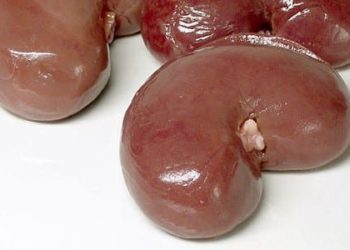Incorporating pharmacists into kidney care model may reduce inappropriate prescription rates
1. Ninety percent of older adults with advanced chronic kidney disease were found to have inappropriate prescriptions (i.e. medications contraindicated for elderly or for patients with CKD) in a median follow up of 2 years.
2. Following the introduction of pharmacists to a kidney care team, there may be a modest reduction in potentially inappropriate prescribing.
Evidence Rating Level: 2 (Good)
Study Rundown: As the population ages, the cohort of older adults (>=65) with advanced chronic kidney disease (CKD) continues to grow. This is a high risk patient group for experiencing adverse drug reactions due to polypharmacy, age-related changes that lead to altered drug pharmacokinetics and pharmacokinetics, altered nutritional state, and reduced kidney clearance of drugs. Consequently, the prevalence of potentially inappropriate prescribing ranges from 13-96% among CKD patients, varying with how either CKD or inappropriate prescribing is defined. While studies have suggested involving pharmacists in CKD patient care can improve prescribing practises, most studies focus on prescribing in acute care hospital settings or in the hemodialysis population. This retrospective cohort study used administrative data form patients in multidsciplinary kidney clinics in Ontario, Canada to examine whether inappropriate prescribing was reduced after pharmacists were introduced. Although no immediate change was detected at pharmacist introduction, results found that the trend of rising potentially inappropriate prescribing pre-pharmacist introduction was reversed post-pharmacist introduction. Findings are in keeping with prior literature that have found a positive association between pharmacist introduction and reduction in inappropriate prescribing. Nonetheless however, the reduction observed here is modest, and further investigation such as through a randomized controlled trial, that could standardize the role and contributions of the pharmacist, in order to determine if therein lies a causal relationship.
Click to read the study in PLOS ONE
Relevant Reading: Drug Management in the Elderly Adult With Chronic Kidney Disease: A Review for the Primary Care Physician)
In-Depth [retrospective cohort study]: This retrospective cohort study included 25 016 patients (mean age 78yo, mean eGFR 19.9 mL/min/1.73m2, mean 10 prescribed medications) from 28 multidisciplinary kidney clinics from April 1, 2011 to March 31, 2017 in Ontario, Canada. Patients <66 years old, lacking an eGFR measurement in the year prior to the cohort index date, with a history of dialysis or kidney transplant, and those with an eGFR >30 mL/min/1.73m2 were excluded. Potentially inappropriate prescribing was defined as, from index date to follow-up, any potentially inappropriate prescription received according to the Beers Criteria (medications contraindicated/prescribed with caution in the elderly) and a modified Delphi panel (medications routine dose-adjusted/avoided in CKD). NSAID use was not included in the databases. The authors calculated the crude cumulative incidence and incidence rate of the primary outcome, or potentially inappropriate prescriptions received, before using change-point regression to determine whether any change occurred following pharmacist introduction.
A cumulative incidence of 22 504 out of 25 016 patients (90%) with potentially inappropriate prescriptions during a median follow-up of 2.0 years (IQR 1.1-3.2 years), was reported, with an overall rate of 125.6/100 person-years (72 453 total person years of potentially inappropriate prescribing over 57 707 total person years of follow-up). By category, the most commonly prescribed potentially inappropriate medications were those of concern in older patients (74.2/100 person years), followed by those of concern in CKD (74.2/100 years). Meanwhile, medications to be avoided at an eGFR <15 mL/min/1.34m2 and those dispensed at higher than recommended doses for an eGFR <30mL/min/1.34m2 were prescribed at low rates (3.4/100 person years and 0.1/100 person years respectively). While no difference in potentially inappropriate prescribing was found between age categories (IRR 0.99, 95% CI 0.98-1.01), there was a higher incidence rate in female patients (IRR 1.13, 95% CI 1.11-1.14). The paper claims there is also a higher incidence rate in more recent index years but there are varying numbers of patients included in follow-up per year and varying levels of significance (2011: IRR 1.01 (0.99,1.04), p=0.34, 2017: 1.06 (0.99-1.14), p=0.08). Medications with the highest cumulative incidence of being potentially inappropriately prescribed were proton pump inhibitors (40%, consecutive use >8 weeks), codeine (30%), peripheral alpha-blockers (23%), ciprofloxacin (21%), and benzodiazepines (21%). While primary care physicians were responsible for writing the most potential inappropriate prescriptions of any specialty (75.6%), they also wrote the most appropriate statin prescriptions (77.3%).
As for the change-point regression analysis, 2 275 patients from two centres were included. Despite no immediate change detected (p=0.14), the slope of the proportion of patients with potentially inappropriate prescribing over time was positive in the months prior to pharmacist introduction (p<0.001), and changed to negative post-pharmacist introduction (p<0.001). When divided by category, a rising trend of potentially inappropriate prescriptions (p=0.003) continued immediately upon post-pharmacist introduction (p<0.001) but declined significantly after (p=0.003).
Image: PD
©2020 2 Minute Medicine, Inc. All rights reserved. No works may be reproduced without expressed written consent from 2 Minute Medicine, Inc. Inquire about licensing here. No article should be construed as medical advice and is not intended as such by the authors or by 2 Minute Medicine, Inc.








